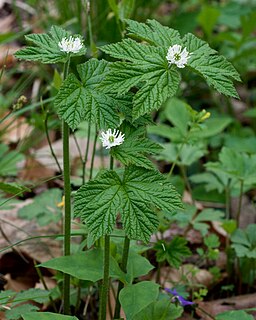
Goldenseal, also called orangeroot or yellow puccoon, is a perennial herb in the buttercup family Ranunculaceae, native to southeastern Canada and the eastern United States. It may be distinguished by its thick, yellow knotted rootstock. The stem is purplish and hairy above ground and yellow below ground where it connects to the yellow rhizome. Goldenseal reproduces both clonally through the rhizome and sexually, with clonal division more frequent than asexual reproduction. It takes between 4 and 5 years for a plant to reach sexual maturity, i.e. the point at which it produces flowers. Plants in the first stage, when the seed erupts and cotyledons emerge, can remain in this state one or more years. The second vegetative stage occurs during years two and three and is characterized by the development of a single leaf and absence of a well developed stem. Finally, the third stage is reproductive, at which point flowering and fruiting occurs. This last stage takes between 4 and 5 years to develop.

Chinese herbology is the theory of traditional Chinese herbal therapy, which accounts for the majority of treatments in traditional Chinese medicine (TCM). A Nature editorial described TCM as "fraught with pseudoscience", and said that the most obvious reason why it has not delivered many cures is that the majority of its treatments have no logical mechanism of action.

Medicinal plants, also called medicinal herbs, have been discovered and used in traditional medicine practices since prehistoric times. Plants synthesise hundreds of chemical compounds for functions including defence against insects, fungi, diseases, and herbivorous mammals. Numerous phytochemicals with potential or established biological activity have been identified. However, since a single plant contains widely diverse phytochemicals, the effects of using a whole plant as medicine are uncertain. Further, the phytochemical content and pharmacological actions, if any, of many plants having medicinal potential remain unassessed by rigorous scientific research to define efficacy and safety.

Coptis is a genus of between 10–15 species of flowering plants in the family Ranunculaceae, native to Asia and North America.
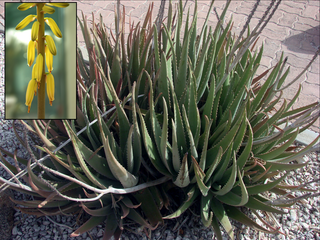
Aloe vera is a succulent plant species of the genus Aloe. Having some 500 species, Aloe is widely distributed, and is considered an invasive species in many world regions.
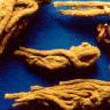
Angelica sinensis, commonly known as dong quai or female ginseng, is a herb belonging to the family Apiaceae, indigenous to China. Angelica sinensis grows in cool high altitude mountains in China, Japan, and Korea. The yellowish brown root of the plant is harvested in the fall and is a well-known Chinese medicine which has been used for thousands of years.

Calycanthus, called sweetshrub, is a genus of flowering plants in the family Calycanthaceae. The genus includes two to four species depending on taxonomic interpretation; three are accepted by most 21st century sources.

Phellodendron amurense is a species of tree in the family Rutaceae, commonly called the Amur cork tree. It is a major source of huáng bò, one of the 50 fundamental herbs used in traditional Chinese medicine. The Ainu people used this plant, called shikerebe-ni, as a painkiller. It is known as hwangbyeok in Korean and (キハダ) kihada in Japanese.
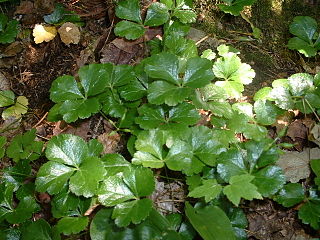
Coptis trifolia, the threeleaf goldthread or savoyane, is a perennial plant in the genus Coptis, a member of the family Ranunculaceae. It is native to North America and Asia across the subarctic region.

Rosa chinensis, known commonly as the China rose, Chinese rose, or Bengal rose, is a member of the genus Rosa native to Southwest China in Guizhou, Hubei, and Sichuan Provinces. The first publication of Rosa chinensis was in 1768 by Nikolaus Joseph von Jacquin in Observationum Botanicarum, 3, p. 7, p. 55.

Berberine is a quaternary ammonium salt from the protoberberine group of benzylisoquinoline alkaloids found in such plants as Berberis, such as Berberis vulgaris (barberry), Berberis aristata, Mahonia aquifolium, Hydrastis canadensis (goldenseal), Xanthorhiza simplicissima (yellowroot), Phellodendron amurense, Coptis chinensis, Tinospora cordifolia, Argemone mexicana, and Eschscholzia californica. Berberine is usually found in the roots, rhizomes, stems, and bark.
Coptis quinquesecta is a species of goldthread native to Jinping County, Yunnan, China and locally in northern Vietnam. China has it as a national key thread species in order to conserve it. It has 79 protein coding genes, 30 RNA transferring genes, as well as four ribosomal RNA genes adding up to a total of 113 genes.

Taxus chinensis is a species of yew. It is commonly called the Chinese yew, though this term also refers to Taxus celebica or Taxus sumatrana.

Coptisine is an alkaloid found in Chinese goldthread, greater celandine, and opium. Famous for the bitter taste that it produces, it is used in Chinese herbal medicine along with the related compound berberine for digestive disorders caused by bacterial infections.

Lobelia chinensis, commonly known as Asian lobelia, Chinese Lobelia, and Herba Lobellae Chinensis, is a species of flowering plant in the family Campanulaceae. It is one of the 50 fundamental herbs used in traditional Chinese medicine, where it has the name.
Coptis teeta is a rare species of flowering plant in the buttercup family.

Huáng bǎi, huáng bó or huáng bò is one of the fifty fundamental herbs of traditional Chinese medicine. Known also as Cortex Phellodendri, it is the bark of one of two species of Phellodendron tree: Phellodendron amurense or Phellodendron chinense.
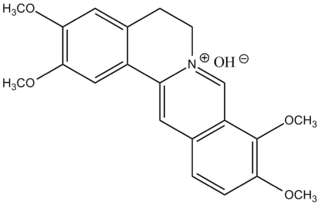
Palmatine is a protoberberine alkaloid found in several plants including Phellodendron amurense, Coptis Chinensis(Rhizoma coptidis,
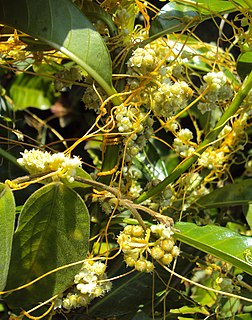
Cuscuta chinensis Lam. is a stem holoparasite vine in the family Convolvulaceae. It was first described in China in 1786.

Coptis japonica, the Japanese goldthread, is a species of flowering plant in the family Ranunculaceae, native to central and southern Japan, and introduced to Korea. In Asia it is grown for medicinal purposes, with the main alkaloid being berberine.

















